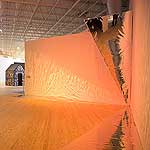Margo Handwerker interviews curator Valerie Cassel Oliver about Black
Light/White Noise: Sound and Light in Contemporary Art, on view at the
Contemporary Art Museum Houston.
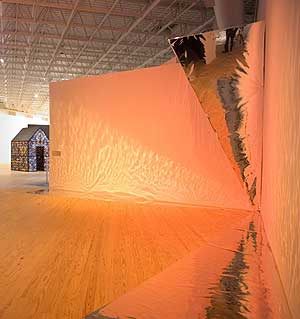
Kira Lynn Harris...Untitled...2007...Silver mylar, lighting, and wood...Dimensions variable...Courtesy the artist
Margo Handwerker: Black Light/White Noise: Sound and Light in Contemporary Art explores the contributions of black artists to the light and sound aesthetic, “blending them with the dynamics and sensibilities inherent in black art.” What are these “sensibilities” and will you highlight, no pun intended, some examples from the exhibition?
Valerie Cassel Oliver: The relation [of the transient qualities of light and sound] to a black sensibility is interesting, particularly if you look at aesthetic legacies from Africa and parts of the southern United States. The concept of transference from the ephemeral to the static, for example, is well documented in vernacular traditions, even though it is not in contemporary art.
The focus of the exhibition is, as you mentioned, to shed “light” on the contributions of black artists working with the ephemeral media of light and sound. It was also to show that these contributions have occurred over decades, hence the historical anchors like Benjamin Patterson and Tom Lloyd, as well as George Lewis and Douglas Ewart. Examples of black artists looking at light and sound in static form predate even the historical work in this exhibition, particularly if you look at painters like Romare Bearden, Alma Thomas, Archibald Motley, and others. I wanted to trace their connections to contemporary art practice—looking at the myriad ways that contemporary art engages light and sound through installation, performance, and technology.
MH: Although the exhibition focuses on works by contemporary artists experimenting with light and sound, you pair them, as you just mentioned, with iconic works by George Lewis, Tom Lloyd, and Benjamin Patterson. How do works by each generation compare?
VCO: The technology has evolved, but many of the investigations are the same. Music and composition remain a common theme, from Lewis and Patterson to SoundLab and Jennie Jones.
MH: Will you talk a little bit about the title, Black Light/White Noise: Sound and Light in Contemporary Art, which establishes a relationship between installations that incorporate light and those that use sound? Some use both. What is the relationship between these types of installations?
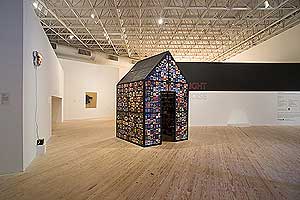
Satch Hoyt...8-Track Shack...2007...Eight-track tapes, metal frame, and speakers...72 x 24 x 72 inches...Courtesy the artist and Anne de Villepoix Galerie...Image by Rick Gardner Photography
VCO: The title evokes thoughts of literal light and sound. I really wanted a way for audiences to “get” how artists work in these forms. Engaging one or both is totally arbitrary. I did, however, want to present different types of practices, ranging from the most simplistic use of materials to elaborate installations that rely on technology. I also thought that it was important to include works that incorporate sculpture, video, and everyday materials—even the architecture of the building.
MH: I like the play on words. Black light illuminates darkness, whereas white noise obscures sound. Yet, both light and sound are sensations that impose themselves on you, whereas you elect to, say, touch. Can you address this language as it relates to individual works or the overall theme?
VCO: Well, I guess to a large extent both light and sound provide an evanescent texture, while touch allows for multiple sensory engagements. But I think to say “impose” alludes to a kind of intrusiveness that is not present in these works. Collectively, the works have a meditative quality that interconnects them on several levels.
MH: On a related note, thematic exhibitions frequently allow for curators to establish relationships between various works based on their position within the gallery. What are your thoughts on this, given that several of the works in this show require a room of their own? Rather than take a moment now and then to consider two or three works simultaneously in relation to each other, viewers have to experience the exhibition pretty linearly, from one “environment” to the next.
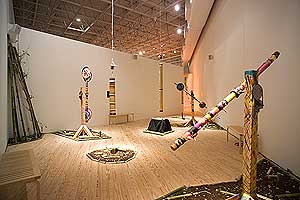
George Lewis (with Douglas Ewart and Douglas Irving Repetto)...Rio Negro...1992...Computer, rainmakers, and sensors...Dimensions variable...Courtesy the artists...Image by Rick Gardner Photography
VCO: What is interesting about Black Light/White Noise is that the sounds from each installation do integrate. It is a moment felt unconsciously when the thunder from Kambui Olujimi’s Kissing Cousins merges with the installation by George Lewis, Douglas Ewart, and Douglas Repetto. This moment is reinforced by Aretha Franklin singing, “I can’t stand the rain,” which sounds from Satch Hoyt’s 8-Track Shack. Kira Lynn Harris’s installation echoes Nadine Robinson’s Wormwood and vice versa. So, while there are specific spaces for each work, they still “find” each other.
MH: Will you address some of the difficulties you faced installing an exhibition composed entirely of installations? One critic admonished you for your decision to install Arthur Jafa’s My Black Death and Satch Hoyt’s 8-Track Shack differently from the way they were described in the exhibition catalogue.
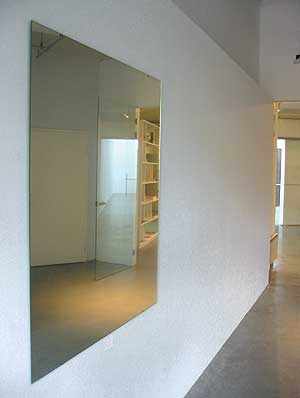
Camille Normant...Driftglass...2001-2004...Mirrors, optic film, proximity sensors, and sound...36 x 24 x 2 inches...Courtesy the artist
VCO: Yes. I thought that article was interesting, but unfortunately it smacked of someone speaking to a process clearly outside of his/her experience. Five works were created specifically for this exhibition, including Hoyt’s 8-Track Shack. The artist initially envisioned it as suspended, but after he completed it, he felt strongly that audiences should be able to enter the shack. That way, the 8-tracks could evoke specific personal moments. It wasn’t my decision, as the writer said. Jafa’s My Black Death, like a few of the other works, was recreated for the space. Again, I accommodated the artist’s wish to install it differently from how he had done previously. Images in catalogues represent works documented in a specific time and place, but installation work evolves. Each new venue presents new challenges and artists adapt. The final results often differ from previous installations.
In terms of other challenges, a lot of the work relies heavily on technology. SoundLab’s Waken, for example, and Camille Norment’s Driftglass, not to mention Tom Lloyd’s Narokan, for which a motor at one point burned out. Each work presents its own special challenges and requires quite a bit of front loaded effort to install as well as to maintain throughout the run of the exhibition.
MH: Also inherent in the title is a contrast between the words “black” and “white,” one that becomes increasingly charged when combined with the words “light” and “noise.” Does the exhibition allude in any way to installations by white artists that involve light and sound?
VCO: No. There is no desire to compare and contrast the work of black artists to that of their white counterparts. The exhibition is more about how black artists are clearly not thought of as working within these practices, and yet they have been doing so for a long time. I hope that the exhibition serves to suggest the limitless manner in which black artists create. Curators, critics, and audiences too often believe that black artists and their practices are monolithic.
MH: You have worked to dispel these attitudes with your other exhibitions. Do you see Black Light/White Noise in relation to, say, Double Consciousness: Black Conceptual Art Since 1970—another exhibition that addresses a dearth of black artists within the art historical canon?

SoundLab (Beth Coleman and Howard Goldkrand)...Waken...2005...Computer, digital audio system, cardboard, and resin...48 x 84 x 12 inches...Courtesy the artists
VCO: The intention of broadening the audience’s view and perspective of art making by black artists is a key factor in both exhibitions. Conversations about black art and black art history are relatively new. There is no repository of black artistic practice, so there is a dearth, as you say, and a lot of catching up has to take place. My effort has been to raise consciousness, to show the range of black art.
Working with contemporary black artists, whether from the United States or elsewhere, I find that they are still viewed as inhabiting the margins, even though they have been engaged in a number of mainstream movements, like conceptual art and Fluxus. I’m trying to bring them to the fore, to show that there is a history of radical black artists who challenge what people consider to be black art.
MH: That having been said, what type of response would you like to receive from this project?
VCO: I hope the immediate response is one of satisfaction at learning how to think in different ways. Beyond that, I hope it serves as a stepping-stone, gives people a desire to dig deeper. Contemporary art is seen as a jumping off point, but I want viewers to know where it comes from. We don’t do our job well enough as curators when we fail to show that contemporary art has a precedent. It’s part of a continuum. There is a Goya in every contemporary artist, a John Cage in every one of them. Contemporary art is nothing but an extension of these same ideas within a contemporary landscape. The same is true of contemporary works by black artists—they are extensions of a legacy that came before.
This interview was conducted through e-mail and over the phone during the month of July 2007.
Images courtesy CAMH.
Margo Handwerker is a Curatorial Assistant of Prints & Drawings and Modern & Contemporary Art at the Museum of Fine Arts in Houston.





